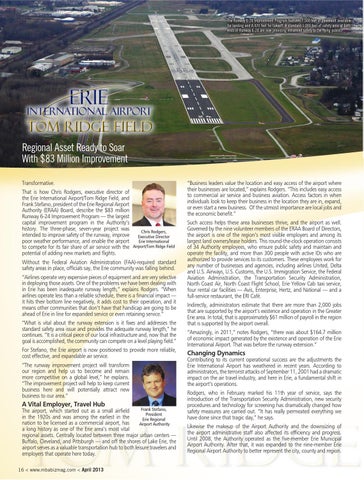The Runway 6-24 Improvement Program features 7,500 feet of pavement available for landing and 8,420 feet for takeoff. A standard 1,000 feet of safety area at both ends of Runway 6-24 are now providing enhanced safety to the flying public.
Regional Asset Ready to Soar With $83 Million Improvement Transformative. That is how Chris Rodgers, executive director of the Erie International Airport/Tom Ridge Field, and Frank Stefano, president of the Erie Regional Airport Authority (ERAA) Board, describe the $83 million Runway 6-24 Improvement Program — the largest capital improvement program in the Authority’s history. The three-phase, seven-year project was intended to improve safety of the runway, improve poor weather performance, and enable the airport to compete for its fair share of air service with the potential of adding new markets and flights.
“Business leaders value the location and easy access of the airport where their businesses are located,” explains Rodgers. “This includes easy access to commercial air service and business aviation. Access factors in when individuals look to keep their business in the location they are in, expand, or even start a new business. Of the utmost importance are local jobs and the economic benefit.” Chris Rodgers, Executive Director Erie International Airport/Tom Ridge Field
Without the Federal Aviation Administration (FAA)-required standard safety areas in place, officials say, the Erie community was falling behind. “Airlines operate very expensive pieces of equipment and are very selective in deploying those assets. One of the problems we have been dealing with in Erie has been inadequate runway length,” explains Rodgers. “When airlines operate less than a reliable schedule, there is a financial impact — it hits their bottom line negatively, it adds cost to their operation, and it means other communities that don’t have that handicap are going to be ahead of Erie in line for expanded service or even retaining service.” “What is vital about the runway extension is it fixes and addresses the standard safety area issue and provides the adequate runway length,” he continues. “It is a critical piece of our local infrastructure and, now that the goal is accomplished, the community can compete on a level playing field.” For Stefano, the Erie airport is now positioned to provide more reliable, cost effective, and expandable air service. “The runway improvement project will transform our region and help us to become and remain more competitive on a global level,” he explains. “The improvement project will help to keep current business here and will potentially attract new business to our area.”
A Vital Employer, Travel Hub
Frank Stefano, The airport, which started out as a small airfield President in the 1920s and was among the earliest in the Erie Regional nation to be licensed as a commercial airport, has Airport Authority a long history as one of the Erie area’s most vital regional assets. Centrally located between three major urban centers — Buffalo, Cleveland, and Pittsburgh — and off the shores of Lake Erie, the airport serves as a valuable transportation hub to both leisure travelers and employers that operate here today.
16 < www.mbabizmag.com < April 2013
Such access helps these area businesses thrive, and the airport as well. Governed by the nine volunteer members of the ERAA Board of Directors, the airport is one of the region’s most visible employers and among its largest land owners/lease holders. This round-the-clock operation consists of 34 Authority employees, who ensure public safety and maintain and operate the facility, and more than 300 people with active IDs who are authorized to provide services to its customers. These employees work for any number of businesses and agencies, including airlines United, Delta and U.S. Airways, U.S. Customs, the U.S. Immigration Service, the Federal Aviation Administration, the Transportation Security Administration, North Coast Air, North Coast Flight School, Erie Yellow Cab taxi service, four rental car facilities — Avis, Enterprise, Hertz, and National — and a full-service restaurant, the ERI Café. Indirectly, administrators estimate that there are more than 2,000 jobs that are supported by the airport’s existence and operation in the Greater Erie area. In total, that is approximately $61 million of payroll in the region that is supported by the airport overall. “Amazingly, in 2011,” notes Rodgers, “there was about $164.7 million of economic impact generated by the existence and operation of the Erie International Airport. That was before the runway extension.”
Changing Dynamics
Contributing to its current operational success are the adjustments the Erie International Airport has weathered in recent years. According to administrators, the terrorist attacks of September 11, 2001 had a dramatic impact on the air travel industry, and here in Erie, a fundamental shift in the airport’s operations. Rodgers, who in February marked his 11th year of service, says the introduction of the Transportation Security Administration, new security procedures and technology for screening has dramatically changed how safety measures are carried out. “It has really permeated everything we have done since that tragic day,” he says. Likewise the makeup of the Airport Authority and the downsizing of the airport administrative staff also affected its efficiency and progress. Until 2008, the Authority operated as the five-member Erie Municipal Airport Authority. After that, it was expanded to the nine-member Erie Regional Airport Authority to better represent the city, county and region.
